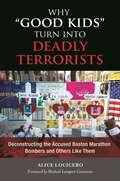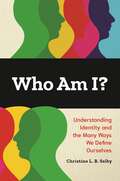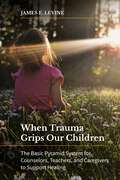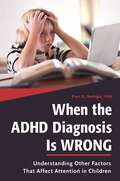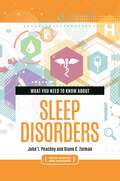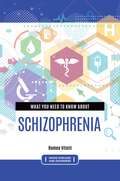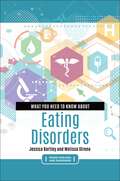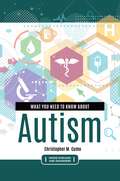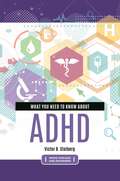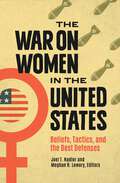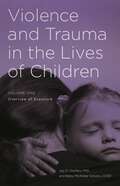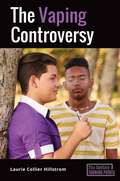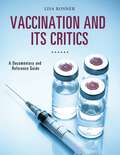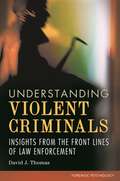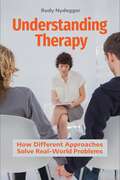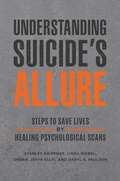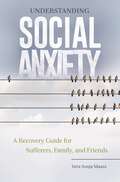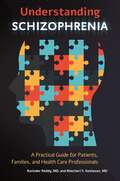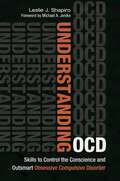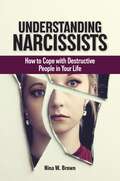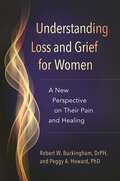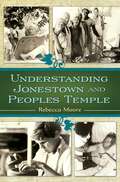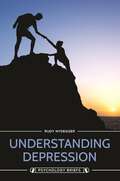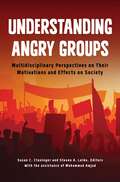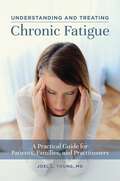- Table View
- List View
Why "Good Kids" Turn into Deadly Terrorists: Deconstructing the Accused Boston Marathon Bombers and Others Like Them
by Alice LoCiceroUsing psychological theory and the author's direct experience working with at-risk youth, this book answers the questions on the minds of anyone shocked and appalled by the events of the Boston Marathon bombings.The shock of the 2013 Boston Marathon bombings was soon followed by a revelation initially disturbing and mystifying: two apparently unremarkable brothers—one a teenager, the other a young adult; both well-liked immigrants and longtime U.S. residents—had allegedly triggered the bombs. Why were these two seemingly "normal" individuals driven to commit such acts of coldblooded violence? This book examines not only the lives, motivations, and key influences of these infamous brothers, but those of other young, unexpected terrorists worldwide, comparing factors that contributed to their decisions to become terrorists and identifying methods used to recruit them into that deadly fold. The chapters teach readers warning signs that youths are being drawn in to terrorism and serve to spur meaningful conversations among citizens, politicians, and policymakers about what we can do to prevent such recruitment of youths and young adults, including other U.S. residents who might consider emulating the Tsarnaev brothers. The book also addresses larger, related questions, such as whether humans are naturally violent, who benefits when young individuals engage in terrorism, and why minors are recruited to become killers.
Who Am I?: Understanding Identity and the Many Ways We Define Ourselves
by Christine L. SelbyThis book explores what identity is, what factors contribute to it, how it develops, and the impacts that a strong or weak sense of self can have on a person's health, happiness, and future.Many teens grapple with the seemingly simple question, "Who am I?" and struggle to integrate their experiences at school, at home, and with friends into their burgeoning sense of identity. How teens see themselves can influence the friends they choose, the decisions they make, and their mental and physical well-being. Having a strong sense of self can help them resist peer pressure, avoid risky behaviors, and make choices and plans that align with their values and interests. Yet research shows that such factors as heavy social media use can have a strongly negative effect on healthy identity formation for today's teens.Who Am I? Understanding Identity and the Many Ways We Define Ourselves examines the subjects of identity and identity formation across the lifespan, with special emphasis on the teenage years. Beyond simply discussing relevant psychological theories, the book focuses on how identity formation happens in the real world and how it affects the daily lives of teens. It also includes a collection of fictional case studies that provide concrete, relatable illustrations of concepts discussed in the book.
When Trauma Grips Our Children: The Basic Pyramid System for Counselors, Teachers, and Caregivers to Support Healing
by James E. LevineAimed at school staff and other caregivers on the front lines of providing assistance without in-depth training or an understanding of how trauma manifests, this book offers a detailed approach to helping children who have experienced trauma.Trauma in children varies in how it presents—in behavior, emotions, learning, and social interactions—and how to address it depends largely on its presentation. Children may exhibit many types of behavior that could be attributed to trauma, such as telling lies and feeling shame, lacking focus or having outbursts in class, and distrusting peers and adults, among many more.When you read this book, you'll learn how to support a child with severe trauma by employing a sensitive yet structured approach. Discussion of a kaleidoscope of case studies using the new Basic Pyramid model, developed by the author, will help you to determine appropriate intervention.
When the ADHD Diagnosis Is Wrong: Understanding Other Factors That Affect Attention in Children
by Paul G. SwingleA game-changing resource for parents caught in the labyrinth of the promoted treatments heralding help for troubled children and their families, this book provides readers invaluable guidance in seeking accurate diagnosis and scientifically verified treatment options.Attention Deficit Hyperactivity Disorder (ADHD) in children is real and can be severely disabling. However, most causes of children's attention problems are unrelated to ADHD and are not resolvable by drugging the child. Treating symptoms is simply not adequate; a completely different approach to the diagnoses and treatment of attention problems in children is necessary. This book identifies the many neurological patterns associated with children's attention challenges, explains the many psychological and physical factors that can affect attention, and describes how to determine if your child needs not medication but other approaches—such as psychological guidance, diet changes, or simply time to develop past childhood—to solve the problem.Paul G. Swingle, PhD, RPsych, provides millions of parents who are desperate for scientifically sound information about how to help their children with conditions that are negatively impacting their learning, development, and happiness with a resource that is precise, definitive, and easy to read. Illustrated with examples from across his 30 years of practice, Swingle's book informs readers about the many factors that can affect children's attention and can often be treated with drugless approaches and therapy for success. Parents will understand how intolerance of what constitutes normal children's behavior and the failure to recognize the emotional challenges that many children have in our culture today constitute causative factors in the misdiagnosis of attention deficit disorders.
What You Need to Know about Sleep Disorders (Inside Diseases and Disorders)
by John T. Peachey Diane C. ZelmanThis book provides readers with the information they need to know about sleep disorders: the process and purpose of sleep, the importance of good sleep hygiene, and the impact of modern life on our quality of sleep.Good sleep is essential for optimal health, yet a number of sleep disorders can interfere with consistent, restful sleep. From insomnia to sleep apnea and from narcolepsy to restless legs syndrome, these conditions can have an enormous impact on both the quantity and quality of an individual's sleep.What You Need to Know about Sleep Disorders is part of Greenwood's Inside Diseases and Disorders series. This series profiles a variety of physical and psychological conditions, distilling and consolidating vast collections of scientific knowledge into concise, readable volumes. A list of "Top 10" essential questions begins each book, providing quick-access answers to readers' most pressing concerns. The text follows a standardized, easily navigable structure, with each chapter exploring a particular facet of the topic. In addition to covering such basics as causes, signs and symptoms, diagnosis, and treatment options, books in this series delve into issues that are less commonly addressed but still critically important, such as effects on loved ones and caregivers. Case illustrations highlight key themes discussed in the book and are accompanied by insightful analyses and recommendations.
What You Need to Know about Schizophrenia (Inside Diseases and Disorders)
by Romeo VitelliAlthough often depicted as aggressive and unpredictable in movies, people with schizophrenia are actually far more likely to be the victims of violence than perpetrators of it. This book sheds light on the realities of this often misunderstood mental illness.Schizophrenia is a mental disorder characterized by delusions, hallucinations, and disordered thoughts and behaviors. Although schizophrenia requires lifelong treatment, early intervention can help individuals effectively manage their symptoms. Even so, it can be a challenging condition to navigate for both the patient and their loved ones.What You Need to Know about Schizophrenia is part of Greenwood's Inside Diseases and Disorders series. This series profiles a variety of physical and psychological conditions, distilling and consolidating vast collections of scientific knowledge into concise, readable volumes. A list of "top 10" essential questions begins each book, providing quick-access answers to readers' most pressing concerns. The text follows a standardized, easy-to-navigate structure, with each chapter exploring a particular facet of the topic. In addition to covering such basics as causes, signs and symptoms, diagnosis, and treatment options, books in this series delve into issues that are less commonly addressed but still critically important, such as effects on loved ones and caregivers. Case illustrations highlight key themes discussed in the book and are accompanied by insightful analyses and recommendations.
What You Need to Know about Eating Disorders (Inside Diseases and Disorders)
by Jessica Bartley Melissa StrenoThis book provides readers with information to better understand eating disorders, written in accessible language for teens and young adults—those most at risk for these potentially deadly mental disorders.Eating disorders, including anorexia nervosa, bulimia nervosa, and binge eating disorder, are some of the most commonly diagnosed mental disorders. They are also the deadliest: in the United States, an individual dies as the result of an eating disorder every hour.What You Need to Know about Eating Disorders is a part of Greenwood's Inside Diseases and Disorders series. This series profiles a variety of physical and psychological conditions, distilling and consolidating vast collections of scientific knowledge into concise, readable volumes. A list of "top 10" essential questions begins each book, providing quick-access answers to readers' most pressing concerns. The text follows a standardized, easy-to-navigate structure, with each chapter exploring a particular facet of the topic. In addition to covering basics such as causes, signs and symptoms, diagnosis, and treatment options, books in this series delve into issues that are less commonly addressed but still critically important, such as effects on loved ones and caregivers. Case illustrations highlight key themes discussed in the book, accompanied by insightful analyses and recommendations.
What You Need to Know about Autism (Inside Diseases and Disorders)
by Christopher CumoThis book offers an accessibly written introduction to autism that make it an indispensable resource for anyone whose life has been affected—directly or indirectly—by this condition.Autism is a spectrum of developmental disorders that can range from mild to severe. Individuals with autism often have difficulties with communication, social interaction, and sensory processing, and may engage in repetitive or restricted behaviors. Beyond this definition, however, what finer points and real-life implications of these disorders do individuals and families affected by autism need to know?What You Need to Know about Autism is a part of Greenwood's Inside Diseases and Disorders series. This series profiles a variety of physical and psychological conditions, distilling and consolidating vast collections of scientific knowledge into concise, readable volumes. A list of "Top 10" essential questions begins each book, providing quick-access answers to readers' most pressing concerns. The text follows a standardized,easily navigable structure, with each chapter exploring a particular facet of the topic. In addition to covering basics such as causes, signs and symptoms, diagnosis, and treatment options, books in this series delve into issues that are less commonly addressed but still critical to understand, such as effects on loved ones and caregivers. Case illustrations highlight key themes discussed in the book and are accompanied by insightful analyses and recommendations.
What You Need to Know about ADHD (Inside Diseases and Disorders)
by Victor B. StolbergThis book offers an accessibly written introduction to ADHD, focusing on the topics that matter most to readers. The information it provides makes it an indispensable resource for anyone whose life is affected—directly or indirectly—by this disorder.Attention deficit hyperactivity disorder (ADHD) is a neurodevelopmental disorder that may lead to difficulties paying attention, problems controlling behavior, and excessive activity. What You Need to Know about ADHD conveys what individuals and families affected by ADHD need to know about it in order to manage its symptoms and to help their loved ones to grow.This book is a part of Greenwood's Inside Diseases and Disorders series, which profiles a variety of physical and psychological conditions, distilling and consolidating vast collections of scientific knowledge into concise, readable volumes. A list of "Top 10" essential questions begins each book, providing quick-access answers to readers' most pressing concerns. The text follows a standardized, easily navigable structure, with each chapter exploring a particular facet of the topic. In addition to covering basics such as causes, signs and symptoms, diagnosis, and treatment options, books in this series delve into issues that are less commonly addressed but critical to understand, such as effects on loved ones and caregivers. Case illustrations highlight key themes discussed in the book and are accompanied by insightful analyses and recommendations.
The War on Women in the United States: Beliefs, Tactics, and the Best Defenses (Contemporary Psychology)
by Joel T. Nadler Meghan R. Lowery Chris E. StoutThe book examines gender roles, gender inequity, and the impacts of both unintentional and purposeful efforts to undermine women's equal treatment in the United States, documenting what women have faced in the past and still face in America today.Although women's rights is a worldwide issue, this book examines how in the United States, an alleged "war on women" is still occurring. Are there only forces opposing women's equality that aim to subvert women's advancement, or are defensive strategies employed as well? What has been the offensive response from women and supportive groups of women? Is there actually substantial evidence of a "war on women," or is the idea primarily political rhetoric? Are the actions and behaviors contributing to gender inequality intentional or unintentional?In this unique collection, experts from multiple disciplines analyze the U.S. women's rights movement, developments, progress, and obstacles. The chapters extend the analogy of this fight for equal rights with a war to document how women's struggle for gender equality is simultaneously a health issue, a political issue, and a wider issue of social justice—a formidable challenge in which women's lives are sometimes literally at stake and at risk. The book's contributors and editors take the unique angle of eyeing the fight for equality on the same level as a war, analyzing this "war" on historical/social/cultural levels (the "battlefield"); identifying policy, political, and legal issues ("major battles"); and explaining how to best fight on personal or individual levels ("skirmishes"). The coverage includes current federal and state initiatives that have fueled concern that women's rights are under continued assault. All of the nearly 162 million women in the United States—and their family members, regardless of sex—are affected by the issues addressed in this book.
Violence and Trauma in the Lives of Children [2 volumes]: [2 volumes]
Explains the neurological, emotional, and behavioral impacts of violence and trauma experienced by newborns, infants, children, and teenagers.Traumatic events known as adverse childhood experiences (ACEs) can affect children physically, mentally, and emotionally, sometimes with long-term health and behavioral effects. Abuse, neglect, exposure to community and domestic violence, and household dysfunction all have the potential to alter brain development and behavior, but few people are able to recognize or respond to trauma in children.Given the prevalence of childhood exposure to violence—with one in four children ages 5 to 15 living in households with only moderate levels of safety and nurturance and infants and children ages 0 to 3 comprising the highest percentage of those maltreated—it is imperative that students and professionals alike be able to identify types and consequences of violence and trauma. This book provides readers with the information they need in order to know how to detect and prevent ACEs and to help children who have lived through them.
The Vaping Controversy (21st-Century Turning Points)
by Laurie Collier HillstromThis work provides an evenhanded and authoritative overview of vaping and its impact on American culture and public health, especially among younger Americans.The 21st Century Turning Points series is a one-stop resource for understanding the people and events changing America today. This volume is devoted to the rapid rise of vaping across the nation, especially among young people. This trend has prompted fierce debate in communities across the country, with some people heralding "e-cigarettes" and other vaping devices as valuable smoking cessation tools and others condemning them for being unhealthy in their own right—and a gateway to future cigarette consumption. The Vaping Controversy describes the key events and people that provided the foundation for the rise of e-cigarettes and vaping, from governmental and medical efforts to reduce traditional cigarette smoking to the emergence and rapid spread of an entire industry devoted to selling vaping devices and accessories. This volume also explores how vaping has influenced youth culture and high school life, its impact on "old school" tobacco companies, and the increasingly visible partisan divide in attitudes about the public health impact of vaping.
Vaccination and Its Critics: A Documentary and Reference Guide (Documentary and Reference Guides)
by Lisa RosnerThis authoritative and unbiased narrative—supported by 50 primary source documents—follows the history of vaccination, highlighting essential medical achievements and ongoing controversies.This timely work provides a comprehensive overview of the scientific breakthrough known as vaccination and the controversy surrounding its opposition. A timeline of discoveries trace the medical and societal progression of vaccines from the early development of this medical preventive to the eradication of epidemics and the present-day discussion about its role in autism. The content presents compelling parallels across different time periods to reflect the ongoing concerns that have persisted throughout history regarding vaccination.Author Lisa Rosner provides a sweeping overview of the topic, covering the development of modern vaccines and practices, laws governing the distribution of vaccines, patients' rights, consumer advocacy, and vaccination disasters. Throughout the volume, primary source documents present the perspectives of researchers, public health specialists, physicians, patients, consumer advocates, and government officials, helping to illuminate the past, present, and future of vaccines on a global level.
Understanding Violent Criminals: Insights from the Front Lines of Law Enforcement (Forensic Psychology)
by David J. ThomasWhat causes people to commit violent crimes? The case studies in this book enable readers to evaluate the motivations behind crimes ranging from arson to rape to gang violence.Violent crime remains a major problem in America: in 2011, there were more than 1.2 million violent crimes committed in the United States. To better grasp the complex reasons behind this disturbing statistic, author David J. Thomas—a police officer and forensic psychologist—conducted an in-depth examination of violent crime to pinpoint why some individuals intentionally inflict pain and suffering upon others. In this book, readers are given access to excerpts from police interviews for each spotlighted crime in the case studies, offering a unique inside look at the true motivations of the criminal. The case studies include examples of arson, crimes against children, gang violence, human trafficking, murder, rape, and robbery. The work also explores the psychology associated with each crime, addresses evidence of corresponding personality types, and delves into victimology.
Understanding Therapy: How Different Approaches Solve Real-World Problems
by Rudy NydeggerThis accessibly written book explores many types of psychotherapy, discussing the history, tenets, advantages, and shortcomings of each. It also compares and contrasts how different approaches address real-world mental health concerns.Therapy and counseling have proved beneficial for tens of millions of Americans, whether to address a serious mental illness or for more everyday issues such as troubled relationships, stress, or grief. Studies suggest that approximately 80 percent of people who receive therapy find it beneficial. A number of effective schools of psychotherapy are available today, each with its own approach, strengths, and weaknesses. Understanding Therapy: How Different Approaches Solve Real-World Problems explores different forms of psychotherapy using clear, non-technical language and a reader-friendly format. Part I provides important foundational information, including the historical development of psychotherapy, common misconceptions, and types of therapists. Each chapter in Part II profiles a different group of therapies, highlighting each one's history, key founders and proponents, tenets, and potential advantages and disadvantages. Part III features a series of real-world situations for which someone might seek therapy and illustrates how several different forms of therapy would address the problem. Readers will be able to compare and contrast these methods, learning how different types of therapy tackle the same issue in varying ways.
Understanding Suicide's Allure: Steps to Save Lives by Healing Psychological Scars
by Stanley Krippner Linda Riebel Debbie Joffe Ellis Daryl S. PaulsonThis book explains why suicide can be alluring to a person aiming to stop his or her traumatic pain—whether its source is bullying, sexual assault, war combat, or other PTSD-invoking events—and details approaches that can prevent suicide.Suicide has been a taboo topic in Western culture. The mere mention of suicide sparks reactive responses that include medical, moral, spiritual, and religious debates. As a result, the authors open an important discussion here, offering an honest and non-judgmental examination of the many aspects involved in the nature of suicide, explaining that above all, people need to learn how to support those struggling with suicidal thoughts or to intercept their own suicidal thinking. The book also includes an extensive review and evaluation of the many available mental health treatments.Special consideration is given to military suicides. U.S. soldier suicides exceed one per day and continue to rise in all military branches, while veteran suicide rates are even higher, averaging 17 per day. Communities, families, veterans, and service members are in need of tools and insights for coping with, navigating, and exposing the suicidal attitudes affecting many current and former members of the military.
Understanding Social Anxiety: A Recovery Guide for Sufferers, Family, and Friends
by Vera Sonja MaassThis powerful book explains the debilitating effects of social anxiety and the development of the disorder, emphasizing the need for a resolution of this disorder and identifying common but unhelpful coping mechanisms as well as true methods to change and live life unafraid of social situations.It is estimated that some 15 million Americans suffer from social anxiety disorder. For these individuals, parties, sporting events, and even workplaces or public shopping environments evoke anxiety and fear. People who suffer from social anxiety disorder—the most common of all anxiety disorders—fear being scrutinized and judged by others in social or performance situations. They know their fear is unreasonable, but are powerless against the anxiety. This book provides comprehensive coverage of social anxiety disorder by covering its history, explaining the symptoms and root causes, and presenting information on how to make the key changes in thought that can help sufferers find relief and be more comfortable in the modern world. The author uses case histories and dialogue in therapeutic settings to provide a realistic depiction of social anxiety that makes the topic more relevant and understandable to clinicians, students, and friends and family members of sufferers who want to help the socially anxious individual. The emphasis on people's resistance to changing or even examining the basis of their underlying beliefs illustrates the importance of this topic to the overall foundation of social anxiety and the urgency of addressing belief systems in the process of resolution and recovery.
Understanding Schizophrenia: A Practical Guide for Patients, Families, and Health Care Professionals
by Ravinder D. MD Matcheri S. MDWritten by two physicians with decades of clinical and research experience in the field, this volume helps readers face schizophrenia by understanding what it is and how it is managed.Schizophrenia is a devastating illness that affects more than two million Americans. Written to help anyone who is faced with managing schizophrenia, whether as a patient, friend, or family member, this accessible book is an ideal first stop for practical, up-to-date information. It includes an overview of schizophrenic disorder and provides answers to common questions that arise at different phases of the illness. This brief and to-the-point guide focuses on dealing with many aspects of schizophrenia—complying with treatment, managing crises, being a caregiver, communicating with the care team, and coping skills. The book also provides practical approaches to common issues, such as financial support, housing, employment, interacting with the legal system, stress management, socialization, and negative emotions. Included are useful forms, lists, and a comprehensive collection of resources to access help and information. The goal of this book is to assist patients and their loved ones to effectively face schizophrenia, achieve maximal recovery, and enjoy a good quality of life.
Understanding OCD: Skills to Control the Conscience and Outsmart Obsessive Compulsive Disorder
by Leslie J. ShapiroOne of the most experienced therapists in the world for treatment-resistant obsessive compulsive disorder (OCD) explains the disorder, the treatments available, and the skills needed to overcome and outsmart OCD.This is an eye-opening study of one of the most common psychiatric ailments diagnosed today—obsessive compulsive disorder (OCD). Written by Leslie J. Shapiro, a renowned therapist at one of the most well known OCD facilities in the world, this reference shares effective treatment strategies and clinical factors for helping therapists, mental health professionals, psychology students, clergy, and others deal with patients coping with this illness. The author offers case examples from her 15 years of residential work with patients, demonstrating how sufferers—even the most treatment resistant—can get control of the condition.Organized into three sections, this guidebook first reveals how OCD and guilt are intertwined and explores survival instincts, cultural factors, and the nature of thoughts. The second section covers aspects of the obsessive conscience such as scrupulosity, moralosity, and obsessive guilt. The book's conclusion describes effective exposure and response prevention strategies for these symptoms and examines methods of treatment that augment and help maintain recovery. An in-depth discussion on the differences between compulsive and impulsive behaviors—as well as other treatment impediments—is included.
Understanding Narcissists: How to Cope with Destructive People in Your Life
by Nina W. BrownThis book identifies the behaviors and attitudes reflective of excessive self-interest and self-centered people and provides a framework for reducing the negative effects that these individuals have on their family, friends, and colleagues.This book will guide readers to understand the various indices of observable and destructive narcissistic behaviors and attitudes that are exhibited in everyday interactions with self-inflated people, focusing on the larger societal impacts of those behaviors. Further, the text makes suggestions for effectively managing the negative impact of the Destructive Narcissistic Pattern (DNP), which includes such attributes as anger and shame, and instructs readers how to grow and develop Healthy Adult Narcissism (HAN) consisting of empathy, wisdom, humor, and zest.This book differs from others on the same topic by illustrating the various ways that excessive self-esteem is portrayed in the media as well as presenting the perspective that there are many different ways to exhibit the varied self-inflated, self-centered behaviors and attitudes in everyday adult behaviors and relationships. By the end, this text aims to encourage healthy valuations of self and others that create a sense of purpose; personal satisfaction; and enduring, meaningful relationships.
Understanding Loss and Grief for Women: A New Perspective on Their Pain and Healing
by Robert W. Buckingham Peggy A. Ph.D.This book can enhance everyone's understanding of how women experience loss and grief, and how they transition to resolution. It is an invaluable resource to women and everyone who supports them—spouses, partners, and family members as well as community and government.Women's grief is often a complex phenomenon—a natural, normal experience, but one that can seriously impact everyone—female or male—at every stage of life. Understanding Loss and Grief for Women: A New Perspective on Their Pain and Healing provides a way to look at how women experience loss through the lens of their socially constructed roles, and in light of the theories and practice of grief therapy and support.The book begins by explaining the social construction of women's traditional, transitional, and modern/postmodern roles, and then addresses the social construction of grief theory and practice in past eras and modern society. Several case studies enable readers to see how social constructs shape women's responses to various causes of grief, such as the death of a spouse or partner, child, marriage (divorce), and career (retirement). The final section of the book examines the health impacts of grief, offers suggestions to ameliorate negative health impacts, and emphasizes how loss and grief for women can be used as opportunities for self-growth.This book serves all members of the general population as well as educators, academics, scientists, and students of disciplines such as psychology, psychotherapy, medicine, sociology, and women's studies. It will enable all women to better understand, deal with, and heal from their loss and grief experience. Male readers will empathize with what their spouses/partners, mothers, grandmothers, siblings, and friends are experiencing in loss and grief and understand how to support healthy transition through grief to resolution. The community at large and care providers will learn how to create a more nurturing and supportive environment for women's grief response.
Understanding Jonestown and Peoples Temple
by Rebecca MooreThis in-depth investigation of Peoples Temple and its tragic end at Jonestown corrects sensationalized misunderstandings of the group and places its individual members within the broader context of religion in America.Most people understand Peoples Temple through its violent disbanding following events in Jonestown, Guyana, where more than 900 Americans committed murder and suicide in a jungle commune. Media coverage of the event sensationalized the group and obscured the background of those who died. The view that emerged thirty years ago continues to dominate understanding of Jonestown today, despite the dozens of books, articles, and documentaries that have appeared. This book provides a fresh perspective on Peoples Temple, locating the group within the context of religion in America and offering a contemporary history that corrects the inaccuracies often associated with the group and its demise. Although Peoples Temple had some of the characteristics many associate with cults, it also shared many characteristics of black religion in America. Moreover, it is crucial to understand how the organization fits into the social and political movements of the 1950s, 1960s, and 1970s: race, class, colonialism, gender, and other issues dominated the times and so dominated the consciousness of the members of Peoples Temple. Here, Rebecca Moore, who lost three family members in the events in Guyana, offers a framework for U.S. social, cultural, and political history that helps readers to better understand Peoples Temple and its members.
Understanding Depression: Ways To Find Hope And Help (Psychology Briefs)
by Rudy NydeggerStraightforward and easy to read yet thorough and accurate, this book provides a complete overview of depression that describes the historical background of clinical depression, the various types of mood disorders, and their impact on the health and well-being of people and society.Depression is a serious health issue that affects a greater proportion of people than many would suspect. A recent report by the World Health Organization stated that depression is the predominant cause of illness and disability for those age 10 to 19 worldwide, and more than 40 percent of U.S. college students reported experiencing symptoms of depression. Written by a clinical psychologist who has treated depressed patients and has also taught and done research in the clinical area for more than 40 years, this book presents the best and most current information that is available about depression that covers general background, theory, research results, and treatment methods in easy-to-understand, nontechnical language.The book discusses the various different types of mood disorders and what their impact is on the health and well-being of people and society. It helps readers to understand how those who are depressed suffer, what it feels like, and how their symptoms affect their daily lives. One chapter of the book is dedicated to answering a very common question regarding depression: "Who gets it, and why?" Many major and different types of depression are covered, including adjustment disorder with depressed mood, atypical depression, depressive personality disorder, dysthymic disorder, major depressive disorder, postpartum depression, premenstrual dysphoric disorder, seasonal affective disorder, and unipolar depression. The final chapter of the book draws conclusions based on the information presented, identifies effective treatments for depression, and suggests ways that individuals can cope with depression.
Understanding Angry Groups: Multidisciplinary Perspectives on Their Motivations and Effects on Society
by Susan C. Cloninger and Steven A. LeiboThis book examines the dynamics that lead to anger in individuals, within groups, and between groups; identifies the role of the media in angry group behavior; and offers solutions for dealing with angry groups and channeling that negative energy in positive ways.In today's society, we see angry groups in many forms—from animal rights and climate crisis activists to citizens opposed to allowing more immigrants of certain ethnicities or religions into the country, militia groups frustrated by acts of domestic terrorism and legislation that limits gun ownership and the ability to carry weapons in public, and those outraged by what they see as police brutality or the unnecessary use of deadly force against people of color. More than just evidence of civil unrest in society, angry groups across history and nations often ultimately affect our politics and our government, for better or worse, and sometimes result in injury, bloodshed, or financial costs that hit otherwise-uninvolved taxpayers. This book demonstrates how people across our nation are involved in, affected by, or harmed by angry groups; covers historical and modern perspectives on angry groups; ands offers suggestions for predicting and influencing the expression of angry group behavior. It provides readers with an understanding of such conflicts and of their origins and dynamics that may offer insights to successful resolution, and it identifies strategies that can reduce the suffering that comes from such conflicts.
Understanding and Treating Chronic Fatigue: A Practical Guide for Patients, Families, and Practitioners
by Joel L. YoungSome doctors still think Chronic Fatigue Syndrome is a "fake" diagnosis. In this book, Joel Young, MD, presents the research, experience, and treatments that prove otherwise.Millions of Americans experience chronic fatigue syndrome (CFS), a continuous exhaustion and a feeling comparable to that of having just run a marathon when all they have done is a daily living task, such as taking a shower or getting dressed.Doctors don't have tests for CFS, and some think it's a faux or psychological disorder. Joel Young, MD, in this heavily researched book, explains why it is a true physical illness and how it may be treated. He details how he successfully treats the symptoms, which can include severe fatigue, "brain fog," chronic pain, and sleep problems. Unlike doctors who recommend exercise, supplements, or opioid medications, Young integrates such options as long-acting stimulants, meditation, and dietary changes to reduce fatigue, as well as non-opioid drugs, medical marijuana, and self-help options including yoga for the associated chronic pain.
